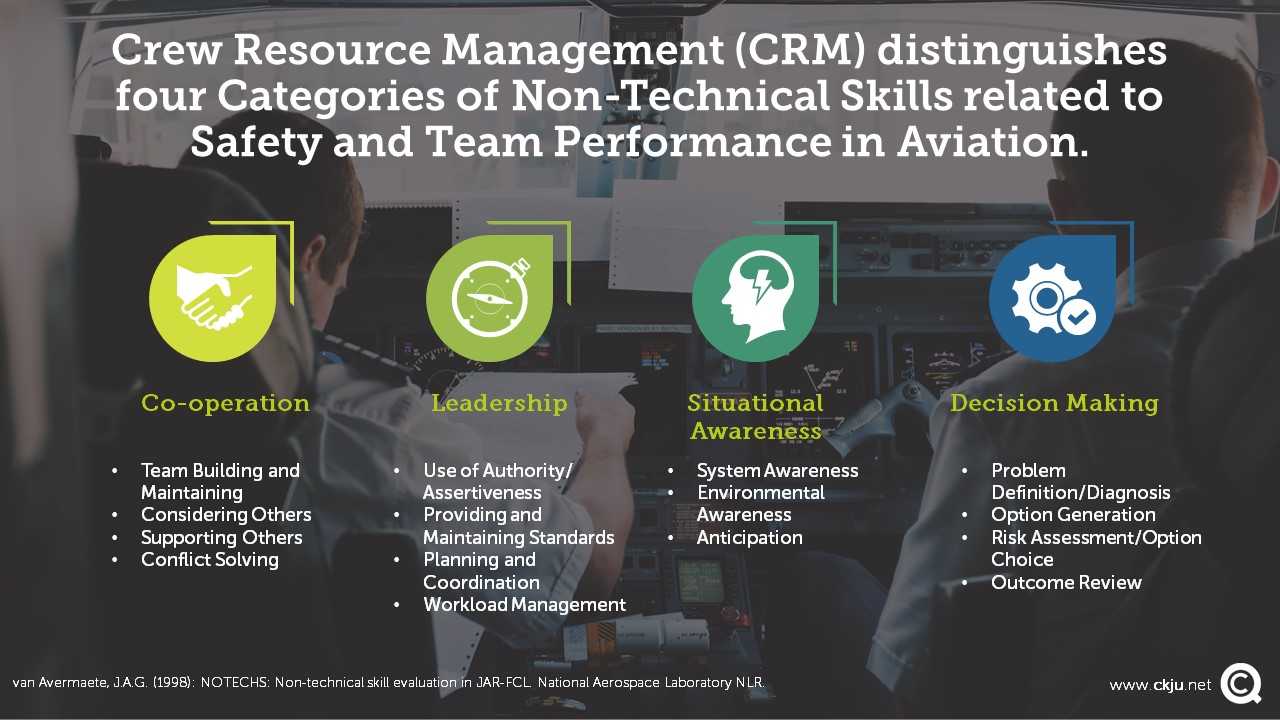- Blog
- Crew Resource Management (CRM)
Contents
- Aviation went through a major change in technology starting in the 1950s
- Complex aircraft systems led to a rise of accidents related to human errors
- Crew Resource Management started in management development
- Organizations outside aviation have adapted Crew Resource Management
- Crew Resource Management increases both safety and team performance
- Crew Resource Management focuses on non-technical skills (soft skills)
- Why should private sector management teams adapt Crew Resource Management for their purpose?
- Crew Resource Management is one of the most-researched team development interventions
- Management (still) relies too much on the “Great Man Theory“
- Most companies operate in a complex and dynamic environment
- CRM incorporates evidence-based practices that have proven their effectiveness in various other contexts
- 737 Max crashes. What do they mean for Crew Resource Management?
- References and further reading
Aviation went through a major change in technology starting in the 1950s
The advent of the jet age in 1950 in civil aviation brought deep and lasting changes to the aviation industry. Looking back to a time where flying was more of a risky adventure than a reliable means of transportation, the advances in technology led to a decline of accidents related to technical issues. However, this much welcomed development has had side effects the aviation industry wasn’t prepared for at that time.
Complex aircraft systems led to a rise of accidents related to human errors
Since its early years, flying an aircraft has been connected to brave and courageous men with a white scarf skillfully maneuvering their aircraft in the blue sky. This idealized “single pilot tradition” (Kanki et al. 2010) still dominates the way many people think about pilots today. However, aviation reality shows a different picture.
Flying with highly sophisticated multi-engine aircraft with 900 kilometers per hour in 30.000 feet above the ground through congested air spaces with changing weather conditions doesn’t require a hero, but a well working and aligned aircraft crew. Something airlines couldn’t rely on in the 50s.
As a consequence the share of accidents related to human factor issues such as communication, decision making and leadership considerably increased to an estimated 60 – 80% peaking in 1977 with over 580 fatalities in the Tenerife airport disaster (Alavosius et al. 2017).
Crew Resource Management started in management development
To address the increasing relevance of human factors in accident prevention, NASA sponsored a workshop initially called Cockpit Resource Management in 1979. Interestingly, the first trainings were developed based on management development interventions from the private sector (Helmreich and Wilhelm 1991).
Since then the scope of the training was increased to the entire aircraft crew and after a set of adjustments Crew Resource Management has become a de-facto standard in the aviation industry.
Crew Resource Management is - to the best of our knowledge - the only industry wide standard on how to address and utilize human factors in teams. One could even say that the aviation industry copied with pride from the business sector and developed it to the next (performance?) level.

Organizations outside aviation have adapted Crew Resource Management
But this is not all. Recently, Crew Resource Management has started to gain traction outside the aviation industry as well. Mostly organizations in high risk environments such as oil and gas, nuclear power, air traffic control and the healthcare sector have started to adapt Crew Resource Management in their domain (Havinga et al. 2017).
Taking all this into consideration, we were wondering what management teams in the private sector can learn from Crew Resource Management taking into account that they face some of the challenges the aviation industry has already gone through.
However, before we have a look at what is behind Crew Resource Management in more detail, we’ll briefly review the evidence whether Crew Resource Management really makes a difference in terms of safety and performance.
Crew Resource Management increases both safety and team performance
The question whether Crew Resource Management has a measureable impact on safety and team performance has been around from the very beginning of its introduction (Helmreich and Wilhelm 1991).
As with many other organizational interventions in complex socio-technical systems, there is no 100% concluding evidence that Crew Resource Management lives up to its promise.
However, there is considerable evidence that supports the claim that Crew Resource Management has a positive impact on safety and team performance (Rudari; Fisher et al. 2000; Nullmeyer and Spiker 2009; Flin et al. 2002).
First results outside the aviation industry point in a similar direction, though the data basis is still weak since CRM has not been around long enough in industries other than aviation (Wagener and Ison 2014; Kanki et al. 2010; KIM and BYUN 2011).
Taking into consideration that companies spend a vast amount of money for training and development measures without any evidence whether they really make a difference, Crew Resource Management is a positive exception.
One of the most important objectives of any learning and development intervention is to maximize the transfer of learning back on the job. Some of the most important determinants to achieve this goal are training design, self-efficacy, goal setting, individual differences and social support. Learn more in our article "How to maximize transfer of learning".
Another argument that makes us believe into the benefits of Crew Resource Management is the fact that it relies on evidence-based management practices that have been proven effective in various other organizational contexts.
However, generalization – even when there is a lot of quantitative evidence available - is always a tricky thing and thus shouldn’t be considered as guarantee for effectiveness. However, taking all this into consideration isn’t it worth having a look at Crew Resource Management in more detail?
Crew Resource Management focuses on non-technical skills (soft skills)
Broadly speaking, Crew Resource Management addresses the human factors individuals and teams need to consider in order to perform well in a complex and dynamic environment best characterized by volatility, uncertainty, complexity and ambiguity (VUCA).
This focus on “soft skills” is also reflected in the term non-technical skills (NOTECHS) which is sometimes used as synonym for Crew Resource Management (Willis and Mellor 2018). While the detailed breakdown of Crew Resource Management skills usually varies between different airlines, there is a set of core NOTECHS skills that cover most of them on an aggregated level.
Alavosius et al. (2017) identify the following six core skills:
- Communication
- Situational awareness
- Decision-making
- Teamwork
- Management of limits of crew members’ capacities
- Leadership
In another approach, van Avermaete (1998) summarizes the NOTECHS in four broad categories instead of six:
- Co-operation
- Leadership
- Situational Awareness
- Decision-making
Communication and management of limits of crew member’s capacities is not listed as stand-alone category but is part of elements located within these categories. For instance, the category co-operating consists of the four elements teambuilding and maintaining, considering others, supporting other and conflict solving (van Avermaete 1998).
Each category has specific behavior description attached which can be used during assessment to measure whether the NOTECHS are implemented as expected. We will have a more detailed look into each of these categories in our next blog posts.
Why should private sector management teams adapt Crew Resource Management for their purpose?
As we have now a first basic understanding of what Crew Resource Management is about, we would like to come up with a set of arguments why private sector management teams should consider to adapt Crew Resource Management to their requirements as means to increase team performance.
Crew Resource Management is one of the most-researched team development interventions
Companies spend a vast amount of money every year for learning & development interventions to improve workplace safety and team performance. Most of those interventions lack evidence and rigor when it comes to measurable outcomes.
Crew Resource Management has been around for almost 40 years with practitioners and scientists closely monitoring it implementing and effect. Thus, when you want to conduct a team development intervention to improve workplace safety and team performance there is no way around Crew Resource Management.
Management (still) relies too much on the “Great Man Theory“
Even though companies have started early to conduct team development interventions, it is still the great man theory, usually represented by the CEO, which dominates boardrooms. Taking into consideration that there is plenty of evidence that leadership is about team development and team performance (e.g. Hogan and Kaiser 2005), one could argument that aviation is ahead of the curve in this regard. Crew Resource Management is the right tool to catch-up.
Most companies operate in a complex and dynamic environment
The environment cockpit crews and other High Reliability Organizations (HROs) are exposed to doesn’t vary too much compared to companies dealing with high-end technology in fast moving and competitive markets. Of course, the risk for a catastrophic incident with a loss of life is usually not imminent in the IT, mechanical engineering or finance sector.
However, when IT systems breakdown, stock markets tumble or products don’t perform companies and even entire countries could get into harm's way. Crew Resource Management which by the way has a strong link to agility gives guidance on how to perform in a VUCA environment.
CRM incorporates evidence-based practices that have proven their effectiveness in various other contexts
A detailed look into Crew Resource Management reveals that it incorporates a set of evidence-based practices that have proven their effectiveness in various other contexts. For instance, Team Mental Models (TMMs), goal setting and situational awareness are evidence-based practices Crew Resource Management utilizes across its core categories. This makes CRM an attractive framework for developing your own learning and development interventions.
When you plan to implement a learning and development intervention to improve safety and team performance you should definitely consider CRM as point of departure. However, as every organization is unique it is necessary to adjust it to your organization’s specific needs and requirements. We’ll have a look at how you can do this in one of our next blog posts.
737 Max crashes. What do they mean for Crew Resource Management?
An unprecedented period of aviation safety has suddenly ended in 2019. Two brand-new 737 Max crashed without any surviving passengers. The root cause for the crash is under investigation by aviation authorities around the world.
The final conclusion is not yet available, however first preliminary results point towards an aircraft system called MCAS which could have played a role in the crashes. What does this mean for Crew Resource Management?
The question which has to be answered is whether the flight crew contributed to the crash or whether the root cause lies in an issue with one of the technical aircraft systems (e.g. MCAS). When the technical system can be pinpointed as root cause, it is not the aircraft crew that has to improve their safety procedures but the company that introduced the technical system without sufficiently proving its effectiveness.
This is another argument for private sector organizations to reflect on their leadership and team development approach. Adapting CRM could be the answer.
References and further reading
Alavosius, Mark P.; Houmanfar, Ramona A.; Anbro, Steven J.; Burleigh, Kenneth; Hebein, Christopher (2017): Leadership and Crew Resource Management in High-Reliability Organizations. A Competency Framework for Measuring Behaviors. In Journal of Organizational Behavior Management 37 (2), pp. 142–170. DOI: 10.1080/01608061.2017.1325825.
Fisher, John; Phillips, Ed; Mather, Jeff (2000): Does crew resource management training work? In Air Medical Journal 19 (4), pp. 137–139. DOI: 10.1016/S1067-991X(00)90006-3.
Flin, Rhona; O’Connor, Paul; Mearns, Kathryn (2002): Crew resource management. Improving team work in high reliability industries. In Team Performance Management 8 (3/4), pp. 68–78. DOI: 10.1108/13527590210433366.
Havinga, Jop; Boer, Robert Jan de; Rae, Andrew; Dekker, Sidney (2017): How Did Crew Resource Management Take-Off Outside of the Cockpit? A Systematic Review of How Crew Resource Management Training Is Conceptualised and Evaluated for Non-Pilots. In Safety 3 (4), p. 26. DOI: 10.3390/safety3040026.
Helmreich, Robert L.; Wilhelm, John A. (1991): Outcomes of Crew Resource Management Training. In The International Journal of Aviation Psychology 1 (4), pp. 287–300. DOI: 10.1207/s15327108ijap0104_3.
Hogan, Robert; Kaiser, Robert B. (2005): What we know about leadership. In Review of General Psychology 9 (2), pp. 169–180. DOI: 10.1037/1089-2680.9.2.169.
Kanki, Barbara G.; Helmreich, Robert L.; Anca, José M. (Eds.) (2010): Crew resource management. 2nd ed. Amsterdam, Boston: Academic Press/Elsevier.
KIM, Sa Kil; BYUN, Seong Nam (2011): Effects of Crew Resource Management Training on the Team Performance of Operators in an Advanced Nuclear Power Plant. In Journal of Nuclear Science and Technology 48 (9), pp. 1256–1264. DOI: 10.1080/18811248.2011.9711814.
Nullmeyer, Robert T.; Spiker, V. Alan (2009): The Importance of Crew Resource Management Behaviors in Mission Performance. Implications for Training Evaluation. In Military Psychology 15 (1), pp. 77–96. DOI: 10.1207/S15327876MP1501_06.
Rudari, Lukas et al.: PowerPoint Presentation. Retrieved from https://flightsafety.org/files/bass/2015/proceedings/Walala.pdf
van Avermaete, J.A.G. (1998): NOTECHS: Non-technical skill evaluation in JAR-FCL. National Aerospace Laboratory NLR.
Wagener, Frank; Ison, David C. (2014): Crew Resource Management Application in Commercial Aviation. In Journal of Aviation Technology and Engineering 3 (2), p. 2. DOI: 10.7771/2159-6670.1077.
Willis, Sam; Mellor, Gary (2018): That final fatal error. Crew resource management. In International Paramedic Practice 8 (1), pp. 10–13. DOI: 10.12968/ippr.2018.8.1.10.
Top Rated
About the Author

Comments
Most Read Articles
Blog Categories
RELATED SERVICES









Add comment